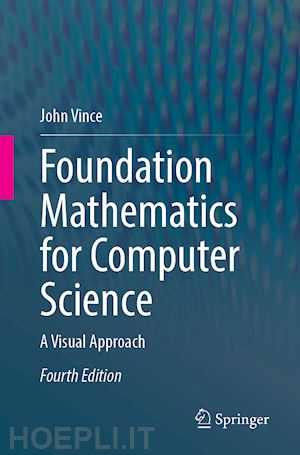
Questo prodotto usufruisce delle SPEDIZIONI GRATIS
selezionando l'opzione Corriere Veloce in fase di ordine.
Pagabile anche con Carta della cultura giovani e del merito, 18App Bonus Cultura e Carta del Docente
In this book, John Vince has reviewed and edited the third edition and added chapters on statistics, Georg Riemann’s hypothesis, eigen vectors, curves, analytic geometry and Fourier analysis. These subjects complement the existing chapters on visual mathematics, numbers, algebra, logic, combinatorics, probability, modular arithmetic, trigonometry, coordinate systems, determinants, vectors, complex numbers, matrices, geometric matrix transforms, differential and integral calculus. During this journey, the author touches upon more esoteric topics such as quaternions, octonions, Grassmann algebra, barycentric coordinates, transfinite sets and prime numbers.
John Vince describes a range of mathematical topics that provide a solid foundation for an undergraduate course in computer science, starting with a review of number systems and their relevance to digital computers and finishing with calculating area and volume using calculus. Readers will find that the author’s visual approach should greatly improve their understanding as to why certain mathematical structures exist, together with how they are used in real-world applications.
This book includes new, full-colour illustrations to clarify the mathematical descriptions, and in some cases, equations are also coloured to reveal vital algebraic patterns. The numerous worked examples will help consolidate the understanding of abstract mathematical concepts. Whether you intend to pursue a career in programming, scientific visualization, artificial intelligence, systems design or real-time computing, you should find the author’s literary style refreshingly lucid and engaging and prepare you for more advanced texts.
Visual mathematics.- Numbers.- Systems of counting.- Algebra.- Logic.- Combinatorics.- Probability.- Statistics.- Modular arithmetic.- Trigonometry.- Coordinate systems.- Curves.- Determinants.- Vectors.- Equations.- Complex numbers.- The Riemann hypothesis.- Matrices.- Geometric matrix transforms.- Analytic geometry.- Eigenvectors and eigenvalues.- Calculus: Derivatives.- Calculus: Integration.- Area.- Volume.- Fourier series.- Appendix A.- Appendix B.
Professor John Vince began working in computer graphics at Middlesex Polytechnic in 1968. His research activities centred on computer animation software and resulted in the PICASO and PRISM animation systems. Whilst at Middlesex, he designed the UK’s first MSc course in Computer Graphics and developed a popular programme of short courses in computer animation for television designers. In 1986 he joined Rediffusion Simulation as Research Consultant and worked on the development of real-time computer systems for commercial flight simulators. In 1992 he was appointed Chief Scientist of Thomson Training Simulation Ltd. In 1995 he was appointed Professor of Digital Media at the National Centre for Computer Animation at Bournemouth University, and in 1999 he was made Head of Academic Group for Computer Animation. He was awarded a D.Sc. by Brunel University in recognition of his work in computer graphics. He has written and edited over 50 books on computer graphics, computer animation and virtual reality, including the following Springer titles:











Il sito utilizza cookie ed altri strumenti di tracciamento che raccolgono informazioni dal dispositivo dell’utente. Oltre ai cookie tecnici ed analitici aggregati, strettamente necessari per il funzionamento di questo sito web, previo consenso dell’utente possono essere installati cookie di profilazione e marketing e cookie dei social media. Cliccando su “Accetto tutti i cookie” saranno attivate tutte le categorie di cookie. Per accettare solo deterninate categorie di cookie, cliccare invece su “Impostazioni cookie”. Chiudendo il banner o continuando a navigare saranno installati solo cookie tecnici. Per maggiori dettagli, consultare la Cookie Policy.